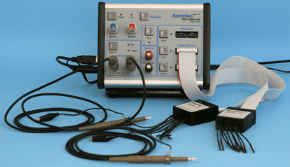Desktop instrument monitors and simulates MCU interfaces
on

The MicroBench MB-500 from Anewin is billed as an all-in-one desktop tool for designing and testing microcontroller, embedded and digital systems. It works in combination with a PC and combines a protocol device simulator and monitor, digital pattern generator, logic analyzer, analogue waveform generator and programmable power supply, along with Anewin's Live Logic 500 MS/s logic capture tool and voltmeter. The MB-500 can simultaneously monitor and source common microcontroller and embedded digital interfaces, even when events are widely separated in time. Interface event capture is based on activity instead of periodic sampling, enabling engineers to see the details of individual bursts, such as protocol transactions, as well as the overall context.
The Live Logic function provides two channels with 500 MS/s digital capture capability for active logic signals with a live oscilloscope-like display. Each channel connects to the test object via a standard 10 MΩ, 10x scope probe for easy browsing. Event auto-tracking enables Live Logic to automatically capture and display any signal activity with a relevant time scale while maintaining full 2-ns event timing resolution. A built-in voltmeter showing the average DC voltage at the scope probe tip is handy for checking supply voltages, logic levels and duty cycles.
To focus on specific events in real time, Live Logic can be configured to watch for events of interest on any channel or combination of channels. Live Logic acquisition capture can operate in single-shot mode, continuous mode, or burst mode with 10 sequential acquisitions. It can also be configured to watch for a defined event from any other MicroBench unit in order to capture the data of interest. Captured data can be examined in the timing display, including any of the multiple acquisitions captured in a sequence, and data can be saved to a CSV file.
For device input control, the MB-500 can source a mix of protocol, digital and analogue signals to simulate signals or an I2C or SPI master or slave device, using the built-in 9-channel, 125 MS/s digital pattern generator. Up to 1000 patterns can be programmed in pattern memory with 8 ns resolution. Patterns can be output in sequence, with sequence control using jump commands. Patterns can be output only once, or a pattern can be looped continuously. Within a pattern, commands can generate events to trigger actions by other MicroBench tools.
Image: Anewin



Discussion (0 comments)